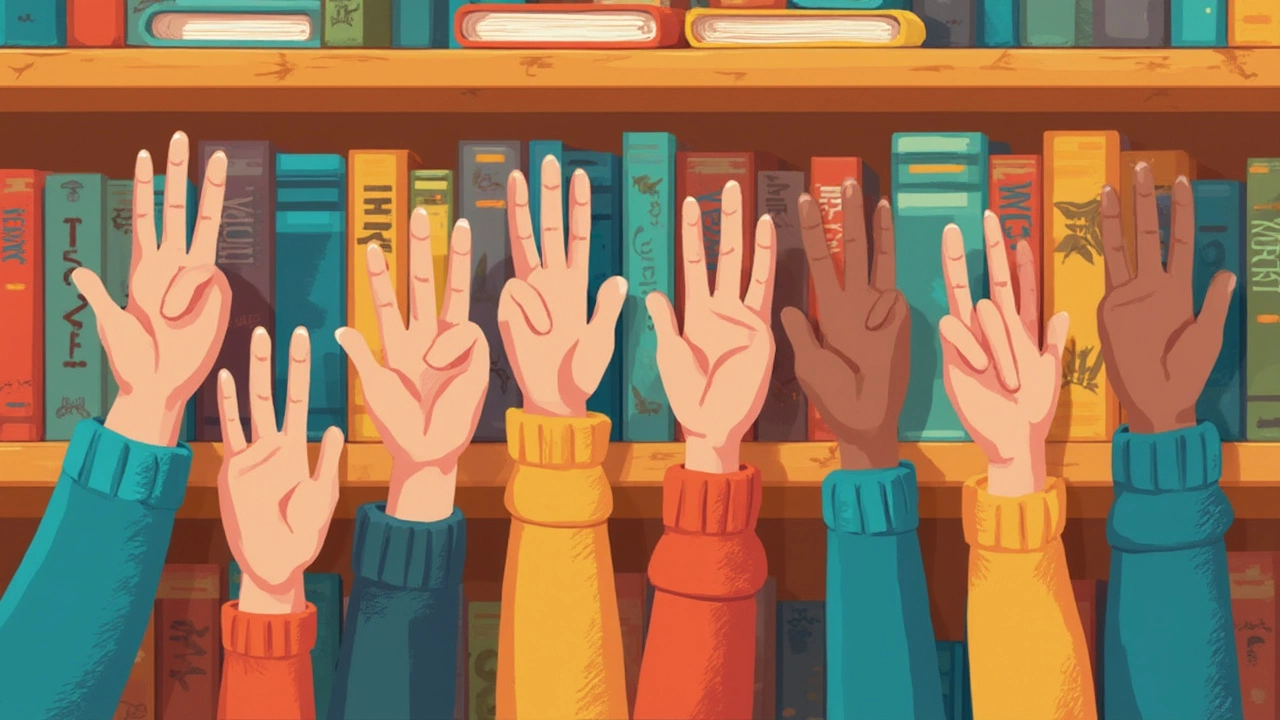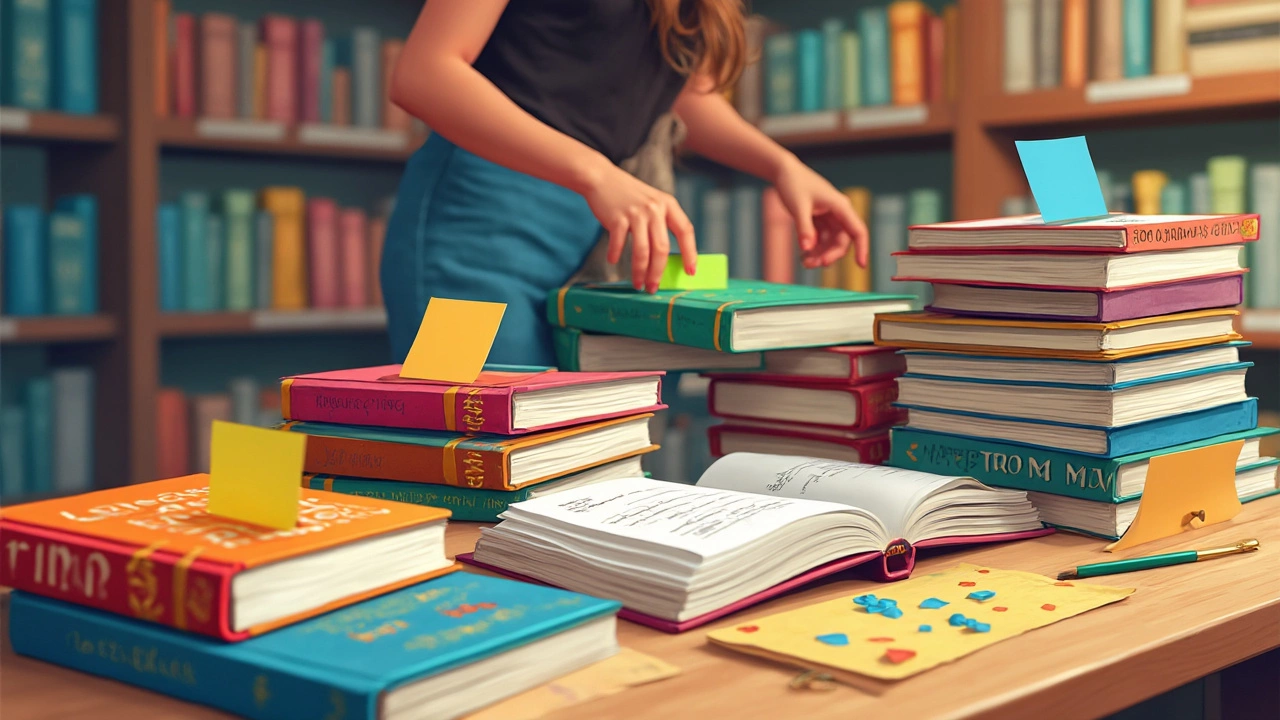
Most people have shelves packed with books they’ve never finished. The 5 finger rule is a dead-simple fix for that problem. It's all about making sure you bring home books you’ll actually want to read—not ones that just look nice on your bookcase.
Here’s the deal: Open a book to any page and start reading. Every time you hit a word that stumps you, raise a finger. If you’re at five fingers before you’re done with the page, the book is probably too tough for now. If it’s only one or two, it’s probably just right.
This trick started out in schools to help kids pick the right stuff without needing a teacher. But it’s not just for kids—it works for adults, too. Whether you love thick mysteries or light travel stories, no one likes to slog through a book packed with words they don’t understand. The 5 finger rule helps you weed those out before they ever make it to your shelf.
- Breaking Down the 5 Finger Rule
- Why It Works for Every Reader
- Using the Rule When Buying or Borrowing Books
- Keeping Your Bookcase Practical
- Smart Bookcase Tips for Every Home
Breaking Down the 5 Finger Rule
The 5 finger rule for books is basically a gut check for whether a book matches your reading skills. It’s super easy—no apps, no calculators, just your own hand.
Here’s how it breaks down for picking out a book:
- Grab a book you’re interested in. Flip to any page in the middle (not too easy, not too hard).
- Start reading that page, word by word.
- For each word you don’t know or can’t figure out, put up one finger.
- If you put up all five fingers before finishing the page, that book might be too tough for a comfortable read right now.
- If you only have one or two fingers raised, the book is probably a good fit.
This method isn’t just a classroom hack—tons of parents, librarians, and even adult readers use it to keep their reading experience enjoyable instead of frustrating. Here’s a quick table showing what each finger count usually means:
| Number of Fingers | What It Means |
|---|---|
| 0-1 | Too easy |
| 2-3 | Just right |
| 4 | May be a challenge |
| 5+ | Probably too hard right now |
Experts say using this rule helps prevent people—especially kids—from getting discouraged and dropping books early. According to a 2023 survey of U.S. parents, 56% said their kids finished more books when they picked ones that matched their level using tricks like the 5 finger rule. If you want to avoid dust collectors on your bookcase, this is the place to start.
Why It Works for Every Reader
The best part about the 5 finger rule is that it just works—most people, no matter their age or reading skill, get tripped up by books that are too far out of their comfort zone. When you use the rule, you stop picking up books that'll sit unread on your shelf. Instead, you focus on those that are a good match for your reading chops right now.
Here's the kicker: research from the National Literacy Trust shows that kids who consistently read books at the right level are three times more likely to finish those books. That means more reading and less quitting. But adults aren't so different; a study in 2023 found that adults who pick books too challenging quit them 57% more often than those who stick with suitable choices.
- It helps prevent frustration. Nothing kills a reading habit faster than a book loaded with confusing words.
- It makes reading fun again, because you're not stuck rereading sentences or searching for definitions.
- The rule works fast, so you can use it right in the bookstore or library before spending money or taking books home.
This simple method can also help you find the right balance. If a book is too easy—no fingers up—it might not hold your interest. Too hard, and you'll probably give up. When a book is 'just right,' you're set up for success.
| Finger Count | What It Means | Recommended Action |
|---|---|---|
| 0-1 | Too easy | Maybe look for something a bit more challenging |
| 2-3 | Just right | Perfect pick—go for it! |
| 4 | A little tough | Be cautious, but give it a try if you're interested |
| 5+ | Too hard | Try again later or look for another book |
So if you want your shelf to show off finished books and not just "someday" hopes, the 5 finger rule makes a real difference. It’s practical, quick, and takes the guesswork out of picking your next read.

Using the Rule When Buying or Borrowing Books
When you’re at the bookstore or the library, it’s easy to get overwhelmed by choices. The 5 finger rule keeps things simple. Don’t just grab the latest bestseller or a book with a flashy cover—actually check if you’ll enjoy and finish it. In fact, plenty of public libraries recommend this rule because it helps people make choices they won’t regret later.
Here’s how to work the rule into your next book hunt:
- Pick a book that grabs your attention. Flip to a random full page inside—it shouldn’t be the first or last page.
- Read the whole page—out loud helps, but you can do it quietly too.
- Count on your fingers every word that you can’t figure out, can’t pronounce, or just don’t understand in context.
- If you get to five fingers before finishing, you’ll probably struggle with this book. If you’re at one or two, it’s a green light. Three or four? It still might work, but be ready for a bit of a challenge.
This isn’t just for people buying books for themselves. Parents helping kids choose books? Same deal. Teachers stocking a classroom library? You bet.
Here’s a quick breakdown so you don’t have to remember:
| Fingers Raised | What It Means |
|---|---|
| 0-1 | Too easy, but fine for a comfort read |
| 2-3 | Just right for most readers |
| 4 | Some challenge, but doable |
| 5+ | Probably too tough right now |
Chances are, if you use the 5 finger rule at the library, you’ll actually finish more of what you borrow. Bookstores? You’ll spend your money smarter. Your shelves won’t be jammed with books that just sit there unread. And that’s the whole point—filling your life, and your bookcases, with stuff you actually enjoy.
Keeping Your Bookcase Practical
Your home bookcase shouldn't turn into a dumping ground for unread books. With the 5 finger rule, you can pick books that fit your reading level and actually get finished. This means your shelves won't just look smart—they'll actually work for you.
A survey from the Pew Research Center found that about 27% of Americans haven't finished a single book in the past year. One big reason? Folks pick books that aren't a good fit. By sticking with what you can read and understand, you're more likely to finish books rather than letting them gather dust.
Here’s how to keep your bookcase working for you, not against you:
- Only add books you've used the 5 finger rule on. This keeps the "too hard, too boring, too much work" titles off your shelf.
- Organize books by difficulty. Put "easy reads" up front so you’re more likely to grab them. Make a "challenge" section for tougher books you want to tackle later.
- Each month, go through your shelves and pull out books you still haven’t touched. If you find five or more pages in a row with five fingers up, consider donating or trading that book.
- Keep a handy "want to read" list. When friends or family recommend books, see if they survive the 5 finger test before buying or borrowing.
- Mix it up. Rotate your bookshelves every season. Research shows people read more when they notice their books instead of ignoring them.
Here’s a quick look at how people tend to use their home bookcases based on a small 2023 organizational study:
| Bookcase Use | Percent of Owners |
|---|---|
| Mainly display finished books | 43% |
| Mix of read/unread books | 48% |
| Mostly unread books | 9% |
So, if you want your bookcase to be more than decoration, try these steps. You’ll waste less time, finish more stories, and maybe even start recommending your own page-turners to friends.

Smart Bookcase Tips for Every Home
If you want your bookcase to actually work for you, it’s time to think a bit more like a librarian and less like a collector. Cramming shelves full of tough reads that just sit there? Pointless. The real magic happens when your books are balanced, easy to find, and more likely to be picked up.
First, use the 5 finger rule—when it comes to bookcases, that means only keep books that match your or your family's reading level. If something’s too advanced, store it in a “future reads” box or on a higher shelf. Books you’ve outgrown can get donated, swapped, or resold.
Want your shelves neat and useful? Try these steps:
- Sort by what you actually read: Fiction, non-fiction, cookbooks, comics—keep categories simple and obvious.
- Put favorites or current reads at eye level. If you’re reaching for a step ladder every time, it won’t happen.
- Use bookends, bins, or baskets for books that kids can grab by themselves. Low shelves work best for children.
- Rotate books seasonally. Fresh picks in plain view mean more things get read.
Still keeping books you just couldn’t get through? That’s normal. About 30% of books on average home bookcases go unread, according to a report by The Reading Agency in the UK. If you clear that clutter, it’s way easier to want to actually read what’s left.
| Bookcase Tip | Impact |
|---|---|
| Keep only right-level books | Increases reading success |
| Store tough books out of reach | Makes picking a book less stressful |
| Rotate choices every couple of months | Keeps interest up |
| Donate or sell old books | Frees up space and helps others |
If space is tight, use double rows or stack sideways—but never so packed you can’t see titles. And don’t worry about making shelves look perfect. A bookcase that’s a little messy and clearly loved is usually one that gets used the most.



